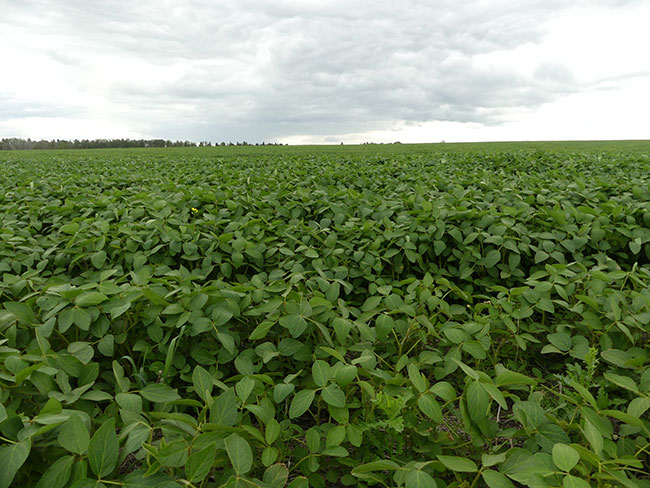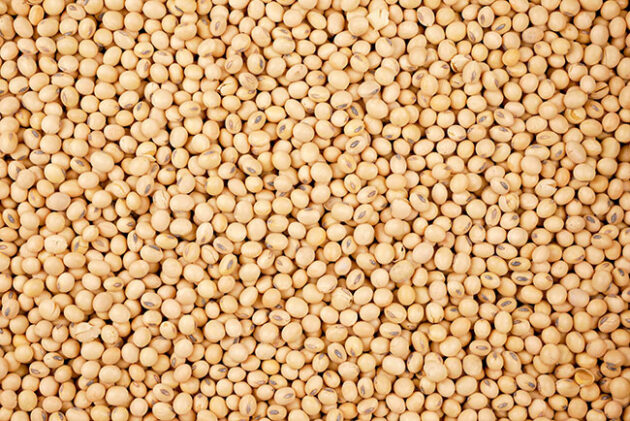
Features
Soybeans
Changing the conversation on soybean protein
Prairie soybeans may have lower crude protein, but are higher in feed quality.
December 6, 2023 By Bruce Barker
 Western soybeans can be lower in protein than eastern beans, but are higher in feed value.
Photo courtesy of Bruce Barker.
Western soybeans can be lower in protein than eastern beans, but are higher in feed value.
Photo courtesy of Bruce Barker.
Soybeans grown on the Prairies are typically lower in seed protein than those grown in Eastern Canada or the U.S. This has led to protein discounts being applied to export soybeans from Western Canada. However, research in Manitoba is trying to reframe the narrative to show that Prairie-grown soybeans are of higher feed quality than may be indicated by just looking at crude protein.
“From a farmer’s perspective, there are no visible discounts. Farmers see either a ‘flat price’ or a futures-plus-basis pricing formula. Prices for Manitoba soybeans have been competitive with both local processors and east/west export demand driving bids to farmers,” says Brian Innes, executive director with SoyCanada in Ottawa, Ont.
While there are no visible discounts, discounts may be structured into the basis based on historical expectations for crude protein on the Prairies. Innes explains there is an informal discount applied at the export position to western Canadian soybeans relative to other origins, as also occurs with soybeans sourced from the U.S. Gulf versus the U.S. Pacific Northwest (PCNW).
“From our conversations with the grain trade, this can range from 10 to 50 cents per bushel for soybeans exported via Vancouver versus the U.S. PCNW. This discount is not explicitly linked to protein but reflects customer preference for beans from one origin versus another,” explains Innes.
Several research studies have looked at the differences in crude protein between Eastern and Western Canada. One study led by Agriculture and Agri-Food Canada research scientist Elroy Cober in Ottawa looked at seed composition, agronomic differences between Eastern and Western Canada-grown soybeans and determined the yield cost of raising western soybean protein. The study ran from 2018 to 2021 with 20 high to low protein genotypes grown at eight locations in Western Canada and two locations in Eastern Canada.
Western locations were at research facilities in Manitoba at Morden, Brandon, Melita and Roblin. Saskatchewan locations included Redvers, dryland and irrigated at Outlook and one location at Saskatoon. Eastern locations were at Ottawa and Saint-Mathieu-de-Beloeil, Que.
In Eastern Canada, the average seed protein was 41.6 per cent. This was significantly higher than eastern Prairie sites (Manitoba and Redvers) at 39.3 per cent and Prairie sites (Saskatoon and Outlook) at 39.7 per cent. Interestingly, an environment x genotype interaction was not observed – a high protein genotype produced high protein across east and west sites.
Cober further looked at the yield penalty that occurred with increasing seed protein content. He found that with an increase of seed protein by one per cent, seed yield was reduced by 46.3 pounds per acre (53.1 kg/ha) at the eastern Prairie sites, 70 lbs/ac (78.4 kg/ha) at the Prairie sites and by 40.3 lbs/ac (45.3 kg/ha) in Eastern Canada.
Seed protein quality was analyzed using the 11S:7S ratio. Seed storage proteins glycinin (11S) and -conglycinin (7S) make up about 80 per cent of soybean seed protein and are indicators of protein quality for soy food and livestock feed. A lower ratio indicates higher protein quality. The research found that seed protein quality using the 11S:7S ratio was higher in Western Canada compared with Eastern Canada.
“Plant breeders and growers may need to select higher protein genotypes at the cost of lower yield if the soybean industry is unable to exploit the protein quality advantage in Western Canada,” reports Cober.
Higher feed value in western soybeans
Another study was conducted by James House, professor and Manitoba Strategic Research chair in Sustainable Protein at the University of Manitoba in 2018 and 2019. Approximately 4,700 whole soybean samples were supplied from 13 different variety trial locations across Manitoba to assess seed crude protein levels and nutritional feed value. On a percent dry matter basis, crude protein levels ranged from 27.3 to 50.5 per cent with an average of 39.1 per cent in 2018. In 2019, the range was 34.1 to 55.3 per cent with an average of 42.2 per cent.
House says feed formulation strategies are moving away from using crude protein as the primary focus in feed value to one that looks at digestible amino acid content. These essential amino acids (EAAs) are necessary in livestock diets, and a deficiency cannot support livestock growth. The EAAs primarily required are lysine, cysteine, threonine, methionine and tryptophan. Together, they are referred to as the critical amino acid value (CAAV), and the higher the value means higher feed value.

Soybean seeds grown in Western Canada have higher feed value than those grown in the east.
Photo courtesy of Nattapol_Sritongcom ADOBE STOCK.
In House’s research, he used near-infrared (NIR) spectroscopy as a simple and fast method to assess protein and amino acid content. House found a negative correlation between CAAV and crude protein content – as crude protein increased, the level of CAAV decreased.
“There was variability in the germplasm as it related to protein and amino acid content, but, overall, there was an inverse relationship,” says House.
Subsequently, House conducted research to look at how the nutritional profile and feeding value of Manitoba soybeans performed in layer and broiler chickens and swine. The research compared Manitoba soybeans from three different sources to one from Ontario. The results are still being finalized for publication in a journal, but House says the data shows some trends.
“There is a partial case for placing a higher value on Manitoba soybeans. Part of the challenge is that even though the amino acid quality was found to be higher, it may not be enough to overcome the lower protein content,” says House.
Another confounding issue is that protein content is very much genotype dependent. Some have higher protein levels and are more stable across climates, temperatures and moisture conditions. Currently, relative crude protein content is not available in the provincial seed guides on the Prairies. With the development of NIR technology to quickly and non-invasively measure crude protein content, the hope is that eventually this information will be available to soybean growers. But unless there is a mechanism, as with high protein wheat, to reward higher protein with premiums, this development may not be of benefit to growers.
Variability in crude protein from year to year is also an issue. “Protein levels fluctuate year to year based on growing conditions, right across North America. In 2022, for example, protein levels in western and eastern Canadian soybeans were the same,” says Innes. “With protein levels being a key driver of the value of soybean meal, higher protein beans are more in demand.”
The issue is very much on the minds of the industry. On Nov. 23, the soybean industry came together for the second Northern Soybean Summit, an event aimed at uniting stakeholders within the feed value chain purchasing western Canadian soybeans. Innes says this gathering serves as a platform for exchanging insights and knowledge regarding the quality and utilization of northern soybeans. The summit fosters open dialogues to enhance the industry’s understanding of the feed value chain’s needs and explore potential collaborative opportunities within the industry.